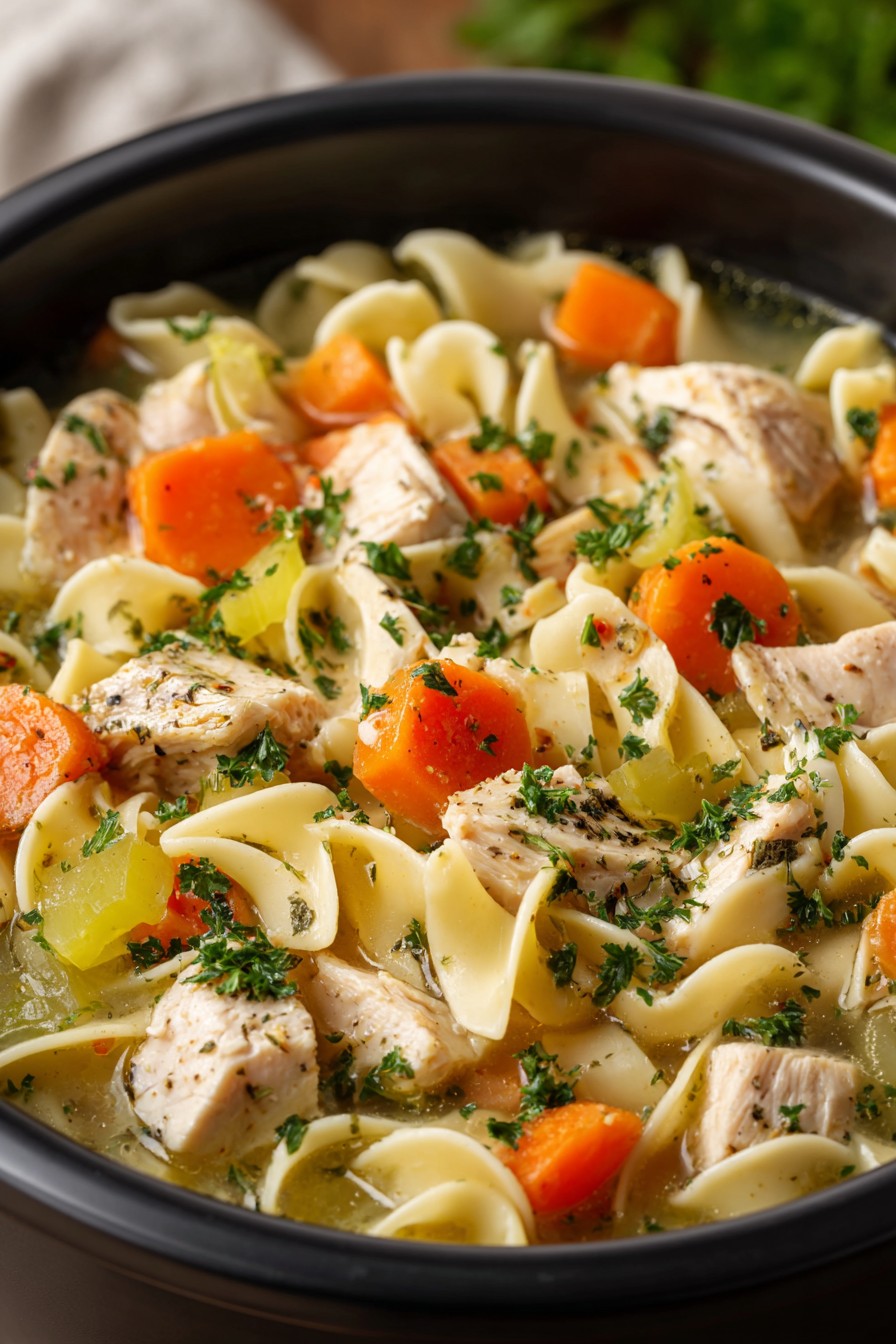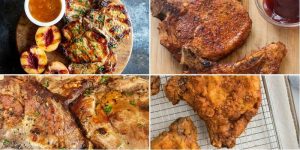Zesty, zippy, and downright delicious—this pressure cooker chicken noodle soup is about to become your new best friend on chilly days or when you’re feeling under the weather. Forget slaving over a stove for hours; this recipe delivers all the cozy vibes in a fraction of the time, thanks to the magic of pressure cooking. Let’s dive into a bowl of comfort that’s as easy as it is satisfying!
Why This Recipe Works
- The pressure cooker locks in flavors and extracts rich, savory notes from the chicken and vegetables in under 30 minutes, mimicking the depth of a slow-simmered soup without the wait.
- Using egg noodles ensures they cook perfectly al dente during the quick pressure release phase, avoiding mushiness and providing that classic, comforting texture.
- Incorporating fresh herbs like thyme and parsley at the end preserves their bright, aromatic qualities, elevating the soup from good to gourmet with minimal effort.
- The balance of sodium from chicken broth and a splash of lemon juice adds layers of umami and acidity, making each spoonful irresistibly flavorful and well-rounded.
- It’s incredibly versatile—easily customizable with add-ins like extra veggies or spices, and perfect for meal prepping or freezing for future cozy cravings.
Ingredients
- 1 tablespoon olive oil
- 1 pound boneless, skinless chicken thighs, cut into 1-inch chunks
- 1 medium yellow onion, finely diced
- 3 medium carrots, peeled and sliced into 1/4-inch rounds
- 3 celery stalks, finely chopped
- 4 cloves garlic, minced
- 6 cups low-sodium chicken broth
- 2 bay leaves
- 1 teaspoon dried thyme
- 1 teaspoon salt
- 1/2 teaspoon black pepper
- 8 ounces wide egg noodles
- 1/4 cup fresh parsley, chopped
- 2 tablespoons fresh lemon juice
Equipment Needed
- 6-quart or larger electric pressure cooker (e.g., Instant Pot)
- Cutting board and sharp knife
- Measuring cups and spoons
- Wooden spoon or spatula
- Ladle for serving
Instructions

Sear the Chicken and Sauté the Aromatics
Turn your pressure cooker to the sauté function on high heat and add the olive oil. Once the oil is shimmering and hot, about 2 minutes, add the chicken chunks in a single layer—don’t overcrowd them! Sear for 3-4 minutes per side until they develop a golden-brown crust, which builds a flavorful foundation for the soup. Then, toss in the diced onion, carrot rounds, and chopped celery, stirring frequently for another 5 minutes until the vegetables soften slightly and the onions turn translucent. Add the minced garlic and cook for just 30 seconds more until fragrant, being careful not to burn it. Tip: For an extra depth of flavor, you can deglaze the pot with a splash of broth after sautéing to scrape up any browned bits from the bottom.
Pressure Cook the Soup Base
Pour in the 6 cups of low-sodium chicken broth, along with the bay leaves, dried thyme, salt, and black pepper. Give everything a good stir to combine, ensuring the chicken and veggies are submerged. Secure the lid on the pressure cooker, set the valve to the sealing position, and select the high-pressure cooking function. Set the timer for 8 minutes—the cooker will take about 10-12 minutes to come to pressure before the countdown begins. This short cook time is enough to tenderize the chicken and infuse the broth with savory goodness without overcooking the vegetables. Avoid peeking during this phase to maintain pressure and efficiency.
Quick Release and Add Noodles
Once the 8-minute pressure cook cycle completes, carefully perform a quick release by turning the valve to venting—stand back as steam escapes vigorously for about 2-3 minutes until the float valve drops. Remove the lid and stir in the 8 ounces of wide egg noodles, making sure they’re fully immersed in the hot broth. Tip: For firmer noodles, reduce the quantity slightly or break them in half before adding to prevent clumping. No additional cooking time is needed here; the residual heat and hot liquid will cook the noodles to al dente perfection as you move to the next step.
Let It Rest and Thicken
Allow the soup to sit off heat for 5-7 minutes, uncovered, which lets the noodles absorb some broth and the soup thicken naturally. During this time, the noodles will soften to a tender yet firm texture, and the flavors will meld together beautifully. Stir occasionally to prevent sticking and check that the noodles are cooked to your liking—they should be pliable but not mushy. If the soup seems too thick, you can add a splash of warm broth or water to reach your desired consistency. This resting period is key for achieving that homestyle soup texture without any gumminess.
Finish with Fresh Herbs and Serve
Stir in the chopped fresh parsley and 2 tablespoons of lemon juice right before serving—this brightens up the soup and adds a zesty kick that balances the richness. Taste and adjust seasoning with more salt or pepper if needed. Discard the bay leaves, as they’ve done their job imparting earthy notes. Ladle the soup into bowls while hot, and enjoy immediately. Tip: For extra freshness, garnish with additional parsley or a drizzle of olive oil. Leftovers can be stored, but note that the noodles may continue to absorb liquid, so reheat with a bit of broth to restore soupy goodness.
Tips and Tricks
If you’re using frozen chicken, thaw it completely in the refrigerator overnight before cubing to ensure even cooking and proper searing—partially frozen meat can lead to uneven texture and longer pressure build-up times. For a clearer broth, consider straining the soup after pressure cooking but before adding noodles; simply remove the solids, skim off any excess fat, and return the liquid to the pot for a more refined presentation. To boost umami, add a tablespoon of soy sauce or a Parmesan rind during pressure cooking—these ingredients dissolve into the broth, adding depth without overpowering the chicken flavor. If you prefer a thicker soup, mix 2 tablespoons of cornstarch with 1/4 cup cold water to create a slurry, then stir it in during the resting phase after pressure cooking and simmer on sauté mode for 2-3 minutes until thickened. For meal prepping, cook the soup without noodles initially, store the base separately, and add freshly cooked noodles when reheating to avoid sogginess—noodles tend to absorb liquid and become mushy over time. To enhance the vegetable content, add a cup of frozen peas or corn during the last minute of pressure cooking or stir in fresh spinach right before serving for a nutrient-packed twist. Always use low-sodium broth to control salt levels, as reducing under pressure can concentrate flavors, and you can always adjust seasoning at the end. For a richer taste, swap half the broth for water and add a chicken bouillon cube, but be mindful of sodium content. Lastly, if your pressure cooker tends to burn messages, ensure you deglaze the pot well after sautéing and avoid ingredients high in sugar or starch that might stick to the bottom.
Recipe Variations
- For a creamy version, stir in 1/2 cup of heavy cream or coconut milk after pressure cooking, along with the noodles, and heat gently on sauté mode for 2-3 minutes—this adds a luscious, velvety texture that pairs wonderfully with the chicken and herbs.
- Swap the egg noodles for gluten-free options like rice noodles or quinoa pasta, adjusting the cooking time slightly since they may cook faster; add them during the resting phase and check for doneness to avoid overcooking.
- Add extra veggies such as diced potatoes, kale, or mushrooms during pressure cooking for a heartier soup—just increase the cook time by 2-3 minutes to ensure they soften properly without turning mushy.
- Spice it up with a teaspoon of red pepper flakes or a dash of hot sauce during sautéing for a kick, or garnish with sliced jalapeños for those who love a bit of heat in their comfort food.
- Turn it into a tortilla soup-inspired variation by adding a can of diced tomatoes, black beans, and corn before pressure cooking, and finish with avocado slices and a squeeze of lime for a Southwestern twist.
Frequently Asked Questions
Can I use chicken breasts instead of thighs?
Absolutely! Chicken breasts work well but require careful timing to avoid dryness. Use 1 pound of boneless, skinless chicken breasts cut into 1-inch chunks, and reduce the pressure cook time to 6 minutes on high to keep them tender. Breast meat has less fat, so it can become stringy if overcooked—always perform a quick release immediately after cooking to stop the process. For best results, shred the chicken after pressure cooking rather than cubing it initially, as it holds moisture better when cooked whole and broken apart later.
How do I prevent the noodles from getting mushy?
To avoid mushy noodles, add them only after pressure cooking during the resting phase, as the residual heat cooks them perfectly without overdoing it. Use wide egg noodles specifically, as they hold up better than finer varieties, and avoid stirring too vigorously once added. If making ahead, cook the noodles separately and add them to individual bowls when serving—this keeps them firm even with leftovers. Always store soup and noodles separately if planning to reheat, and use within 2 days for the best texture.
Can I freeze this soup?
Yes, but with caution—freezing can alter the texture of the noodles, making them soft and bloated. For better results, freeze the soup base without noodles; after pressure cooking, cool it completely, then store in airtight containers for up to 3 months. When ready to eat, thaw in the refrigerator overnight, reheat on the stove, and add freshly cooked noodles. If you’ve already added noodles, expect a thicker, stew-like consistency upon reheating; stir in extra broth to loosen it up.
What if my pressure cooker doesn’t have a sauté function?
No worries! You can sauté the chicken and veggies in a separate skillet on the stove over medium-high heat before transferring them to the pressure cooker. Follow the same steps: sear the chicken until browned, then sauté the vegetables until softened, deglazing the skillet with a bit of broth to capture all the flavorful bits. Add everything to the pressure cooker along with the remaining ingredients, and proceed with the pressure cooking as directed. This extra pan might mean more cleanup, but it ensures that deep, caramelized flavor.
How can I make this soup more kid-friendly?
To appeal to little ones, omit strong herbs like thyme and use milder seasonings such as a pinch of garlic powder instead of fresh garlic. Cut the chicken and vegetables into smaller, bite-sized pieces for easier eating, and consider blending a portion of the soup after cooking to create a smoother texture if they’re picky about chunks. Serve with fun toppings like grated cheese or crackers, and reduce the salt slightly—kids often prefer simpler flavors, so let them customize their bowl with add-ins.
Summary
This pressure cooker chicken noodle soup delivers classic comfort in under 30 minutes, with tender chicken, al dente noodles, and a savory broth infused with fresh herbs. Perfect for busy days or cozy nights, it’s customizable, easy to make, and sure to become a family favorite.
Pressure Cooker Chicken Noodle Soup
5
servings10
minutes20
minutesIngredients
Instructions
- 1 Sear chicken and sauté vegetables in the pressure cooker on sauté mode.
- 2 Add broth and seasonings, then pressure cook on high for 8 minutes.
- 3 Quick release pressure, stir in noodles, and let rest for 5-7 minutes.
- 4 Finish with parsley and lemon juice, then serve hot.



